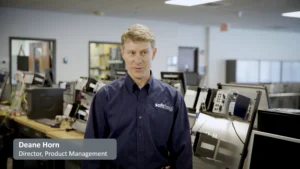What the New Microsoft HoloLens 2 Headset Means for Your Business
The new Microsoft HoloLens 2 headset is due for release later this month, and its new features are destined to make an impact in the Augmented Reality (AR) field and several other sectors.
The new HoloLens model possesses widened visibility with improved pixel resolution. An enhanced interface consisting of entirely digital buttons and graphics will help businesses tackle new workplace tasks.
The original HoloLens was released in early 2016. It contained, among other options, an at-your-fingertips version of the Minecraft video game that could be played through mixed reality technology over a table.
However, with its lightweight design and compact structure, the HoloLens 2 appears well on its way to surpassing its predecessor and becoming a mainstay of the modern workplace, not just peoples’ homes.
Broadened Use and Improved Accessibility
While earlier versions of Microsoft’s mixed reality initiatives, including the original HoloLens, were not designed for public use and largely implemented for promotional events and demos, the HoloLens 2 was crafted exclusively for business use.
Erik Bergstrom, Program Manager at Microsoft’s Xbox Live Compute cloud gaming network, emphasized “customer obsession” as a trademark of the company’s business development strategy.
“We want to make sure that we’re building the right products for our customers,” he said. “We do that in looking at the field and what the opportunities are for our customer base.”
At $3,500, The HoloLens 2 remains in the same price range as its $3,000 predecessor. The additional $500 is said to account for a larger product versatility.
Working Across Industries
Emma Roudabush, a Software Engineer for Microsoft Visual Studio – a program that developers use to code their own software – addressed the live updates to various products that help Microsoft users benefit from all the latest technology.
“We’ve recently just released Visual Studio 2019, and we’re always adding to it because it’s more of a continuous basis type of thing,” she said.
While discussing the broad use of Microsoft products, Bergstrom said he works with game developers and medical workers alike to help expand the scope of Microsoft products.
“We spend a lot of time in product development phases,” he said. “For example, [with] the adaptive controller for Xbox – it’s a unique button for the Xbox or for PC, and then it has modular inputs at the back for you to plug in whatever controllers work for you.”
Constant Upgrades for Constant Care
Roudabush and Bergstrom both hinted at the heightened application of new products such as the Xbox controller in medical care.
“We worked very closely with hospitals with people that were recovering from paraplegic or quadriplegic accidents to help them retrain their body,” he said. “[The adaptive controller] is built over a two- to three-year period, and we used an integrative process to make improvements over time.”
As for the HoloLens 2, Bergstrom would not reveal any secrets. However, he did explain that Microsoft carefully times and considers each new release prior to going public.
“We want to make sure that we get good customer feedback before we actually debut a product,” he said. “We worked very closely with the disabled community to figure out what their needs were.”
The Sky Is the Limit
Regarding AR products, Roudabush said enhancements are always a priority.
“What I’m seeing is we’re just trying to make the development experience better,” she said. “There’s some interesting applications with gaming – I think even with HoloLens 1, we partnered with Case Western [Reserve University] and did some stuff about anatomy visualization for teaching applications.”
Roudabush added that in the AR field, Microsoft possesses boundless potential with countless software advancements occurring daily.
“AR is really applicable to anything,” she said. “Anything that you could dream, we’re maybe looking at.”
For the latest in software and technology news, head to our industry page! You can also get up-to-the-minute updates by following us on Twitter @TechMKSL. Join the conversation in our Market Leaders LinkedIn Group, here.








